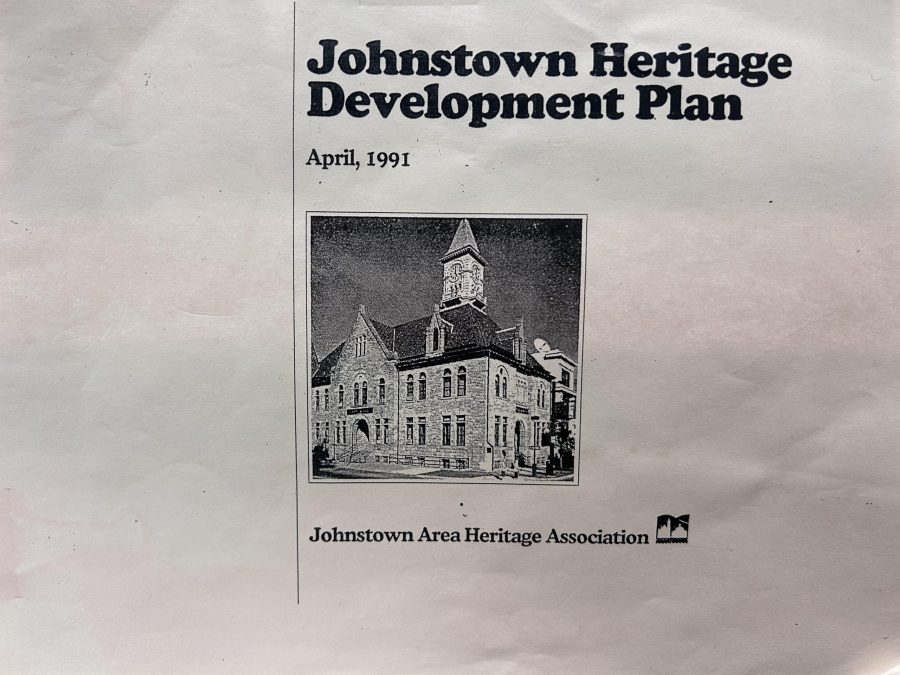
Posted: September 27, 2023 1:46 pm
This column by Chip Minemyer appeared in the September 24, 2023 edition of The Tribune-Democrat and is reproduced here with permission.
In April 1991, just two years after the Johnstown flood centennial and 12 years into Richard Burkert’s time in Johnstown, the local heritage association released a strategic plan with goals to preserve the region’s historical assets and grow cultural tourism.
And guess what? The Johnstown Area Heritage Association and its partners actually achieved many of the concepts outlined in its Johnstown Heritage Development Plan – with some proposals continuing to unfold even as Burkert retires after 44 years leading the region’s cultural heritage efforts.
“Usually, these types of plans don’t get implemented,” Burkert said shortly after stepping aside on Aug. 31. “This one mostly did, and that just shows you the importance of planning.”
Consider these points made in the planning document and the outcomes that have emerged since:
The area around Bottle Works and Venue Of Merging Arts on Chestnut Street near Ace’s has blossomed into exactly what the strategic plan envisioned.
Several concepts in the plan were adjusted, revised or set aside – such as:
The plan proposed: “Passengers would move in trolley cars of the type which operated in Johnstown during the height of the steelmaking era …”
A trolley terminal was envisioned near the Glosser Brothers Department Store on Franklin Street, with cars carrying shoppers and tourists along Washington Street – to the Johnstown Flood Museum and Penn Traffic Co. – and on to the train station and the West End. Trolleys instead were relegated to Johnstown’s history books, and an effort earlier this year to find investors for a single trolley in need of repairs generated scant response.
Still, Burkert said, much has been accomplished – even as state and federal funding dwindled and more of the preservation and marketing burden shifted to private investors and local fundraising.
“We had done the flood museum project (in 1989),” he said. “There was a lot more money around then, both federal and state, so you could do discretionary planning.”
Burkert has turned JAHA leadership over to Patty Carnevali, who said the organization is moving forward in the development of its next strategic plan for cultural heritage – building on the successes of that 1991 document while reflecting new realities.
Working with a changing board of directors and an evolving JAHA staff, the new president said, and with information from the community, she hopes the new strategic plan will be finished by Dec. 1.
Carnevali said JAHA faces the same challenges all nonprofits face in raising money in the COVID-19 era – while benefiting from grants and government programs for larger projects.
“JAHA is not a fearful organization,” Carnevali said. “We’re still going to plan, to hope, and to look at ways to be a cultural tourism driver and an historic preservation leader.
“If JAHA had been fearful all those years ago, a lot of what has been accomplished would never have been realized.”
Burkert came to Johnstown in 1979 as a historian and a storyteller, and then found himself in the crucial role of economic development. And he said the key to a successful plan – and a vibrant community – is having a great story to tell.
“What makes a place interesting to visit is the same things that make people want to live there,” Burkert said. “If you’re trying to increase awareness of Johnstown for its culture and history, understand that people are drawn to communities with a sense of place.”
Renewed interest by private investment in city properties is a good sign, Burkert said.
“People are coming back here,” he said. “They see an opportunity. … The misperception always was that if you get an education, you get stranded here. But as you keep looking at Johnstown, you scrape off a lot of layers until you get to know that place – and it’s worth it.”
Burkert hopes people continue to visit the flood museum – as a million have done already – perhaps getting off a train nearby and also visiting a festival, a restaurant or another local historic site.
Those steps fall together along a path to a meaningful and successful Johnstown experience, he believes – for JAHA and the region collectively.
“We don’t stop at the walls of a museum,” he said. “There’s something far more ambitious and something with far greater impact on the community happening here. The main focus is our service to the community. …
“It can’t just be a museum. You have to be working in economic development and have an impact on the community.”
The April 1991 Johnstown Heritage Plan can be downloaded: